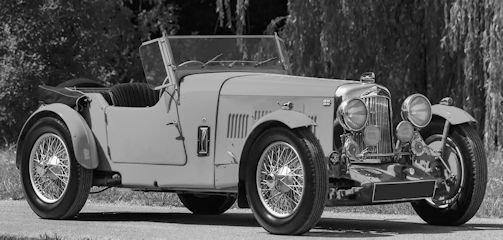Aston Martin 1.5-litre Mk II
 |
|
| Manufacturer | Aston Martin |
|---|---|
| Production | 1934 to 1934 |
| Class | Sports car |
| Engine | 1.5 L I4 |
The Aston Martin 1.5-litre Mk II was a sports and race car from the 1930s.
History
In 1934 a long chassis appeared carrying full four-seat tourer, coupé and saloon bodies, and in 1935 the Mark II emerged, identified by its chromed radiator grille and featuring a modified engine, still of 1495 cc but with improved crankshaft and valve-gear design.
Aston Martin management divided their time, with Bertelli tending to the sports and racing cars, and Arthur and Gordon Sutherland aiming to give
the somewhat rough-and-ready Aston Martins rather more refinement and sophistication in an attempt to broaden their market appeal.
The car featured an open body placed on the short chassis from the Le Mans. Despite the car having the appearance of a four. seater, the rear seats were in reality little
more than additional luggage space.an extra £30 bought you the saloon version, whose unusually long wheelbase meant that
the passengers in the second row could sit comfortably in front of the rear axle. This feature also allowed the roof line to be lowered, contributing to the car's
sleek lines along drophead coupé incorporating an intricate roof construction was available on the same chassis.
The frame had been strengthened and stiffened and the two front Hartford frictional shock absorbers were mounted transversely rather than longitudinally
so that the outer arms were now directly coupled to the wheel carriers improved the road holding.
The tight-fitting motorcycle-style front mudguards which responded to the steering were retained. This allowed the car's low nose to be kept.
The Mark II's small four-cylinder power unit of an English film butler. once the bulky crankshaft had
The lubrication Systemhad one pump feeding nine Liters a minute to the bearings, while a second forced the oil hack into the tank. Along with the thermostatically-controlled radiator louver in place of the normal wire grille gave the car a top speed of 85 mph the 1.5 Liter, with a compression of 9.5:1, polished ports and two large carburettors’ boosting it to 80 horsepower at 5200 rpm.
The brakes were cable-operated, with Alfin drums and 18-inch wheel rims.
When the team won the TT team prize in 1934 the stage was set for a super sports model named the Ulster in 1935. Offering 80 bhp at 5250rpm and with a top speed of 102 mph, this was a true sports car which did much to confirm Aston Martin's ever-growing reputation. Their influence was first felt in the Mark II, and 166 specimens of the new era were sold between January 1934 and December 1935.
Manuals
-
Aston Martin Previous 2 / 63 Next
